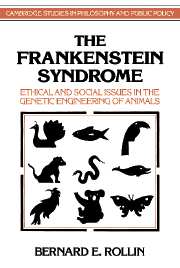3 - The plight of the creature
Published online by Cambridge University Press: 05 June 2012
Summary
ANIMAL WELFARE AS A PURELY MORAL CHALLENGE
The sorts of questions considered in the last chapter represent a mixture of ethical and prudential concerns. Ultimately, the weighing of risks and benefits, the anticipation of dangers, and the determination of mechanisms for minimizing and controlling them are dictated by rational self-interest for all parties to the discussion, even those who stand to gain the most from the genetic engineering of animals. Most of the risks I outlined are as much of a danger to the genetic engineer or to the advocate of genetic engineering as they are to the opponents of genetic engineering. Guarding against changes in pathogenicity of organisms, containment of dangerous animals, minimization of environmental despoliation, restriction of monstrous weaponry are all things that any rationally selfinterested person would set as a fundamental priority because athey can affect us or those we care about. Indeed, those working in the field of genetic engineering are probably at greater risk than the general public, because of their increased contact with the animals.
Those with a vested interest in the science and technology of genetic engineering are also vulnerable at another level, as has already been pointed out. Any catastrophic outcomes of genetic engineering are likely to eventuate in the imposition of severe restrictions on both research and its practical applications and in wholesale public rejection of biotechnology, as they will play directly into the hands of the doomsayer.
- Type
- Chapter
- Information
- The Frankenstein SyndromeEthical and Social Issues in the Genetic Engineering of Animals, pp. 137 - 214Publisher: Cambridge University PressPrint publication year: 1995

